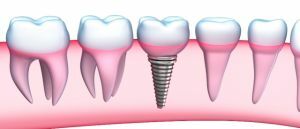 Basal implantation in dentistry is usually called a technique in which the dental implant itself is inserted into the basal layer located in the jawbone tissue. It is characterized by a special density and is not subject to atrophy, i.e.spillage.
Basal implantation in dentistry is usually called a technique in which the dental implant itself is inserted into the basal layer located in the jawbone tissue. It is characterized by a special density and is not subject to atrophy, i.e.spillage.
In addition, this procedure is single-phase - after 4-5 days the doctor can perform prosthetics and there is no need to wait more time after surgery, reducing the rehabilitation period to a minimum.
Contents
- Sinus-lifting let's say goodbye
- Basal VS traditional
- Step-by-step installation of prosthetic devices
- Patient preparation and diagnostic measures
- Modeling process
- What for everything was started
- Opinion of patients
- Word to professional
- Cost of treatment
Sinus-lifting let's say goodbye
Sinus -lifting - this is a very common surgical intervention, practiced with classical procedures of tooth implantation in the lateral part of the upper jaw. The essence of the operation is to increase the thickness of the bone due to the insertion of bone material into the lateral, maxillary sinus.
Sinus-lifting with classical implantation of teeth is mandatory when it comes to a 2-step procedure. 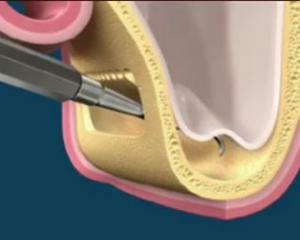
But it is with the application of basal implantation, called another 1-stage, that the sinus-lifting is excluded.
Due to the special form of the basal implant, the subgingival part can go around and do not affect the maxillary sinus and as a result - minimizing or completely eliminating the need for bone growth at the sites of future implant implantation.
Basal VS traditional
The main differences between basal implantation and traditional:
- Basal prosthesis can be performed almost immediately , after 2-3 days, after a single surgeon intervention - in this case, it is possible to establish a non-removable orthopedic structure without problemsto carry out one procedure in several stages, as is done with classical prosthetics.
- Minimum request for bone volume and thickness, and as a result - , there is no need to perform the sinus lifting of and as a result a reduction in the percentage of trauma, treatment time and cost. In the classical procedure of prosthetics, it is the volume and thickness of the jawbone that plays the leading role - if it is insufficient, it must be increased, and this is additional trauma and a longer period of rehabilitation.
- Resistance to the negative effects of pathogens and infections .The main reason for the loss of an artificially inserted implant is an infection that gets into the bone through a hole made in the gum, but the shape, as well as the ways of processing the basal inserts, excludes this possibility of infection.
- Has no contraindications to , in contrast to other methods of dental treatment and prosthetics due to various reasons such as diabetes or the presence of an autoimmune disease or when the classical implantation technique was not considered favorable.
- The percentage of injuries and healing times are minimized by , since the basal procedure does not even involve suturing and is considered to be the best, bloodless method of treatment. With the classical method of prosthetics, the entire process can be carried out in several stages and this is additional trauma and stress for the body, a longer period of rehabilitation.
All this is the strengths of the basal method of denture replacement and its difference from the classical version used in dentistry.
Step-by-step installation of
prosthesis The very process of basal implantation consists of 4 stages - the preparatory stage, which is diagnosed, simulated, implant is directly installed and prosthetics. But all gradually.
Patient preparation and diagnostic activities
The first stage involves initial diagnosis and takes no more than 1 to 2 days. The task at this stage is comprehensive, complete and thorough examination of the patient, in particular, placing emphasis on the study of the structure and condition of bone tissue, as well as the oral cavity.
At this stage, an X-ray examination or tomography can be performed on computer equipment.
Before the basal implantation, the patient is also given a blood sampling, and the patient should be informed of the medical condition of the patient, as this will in many respects determine the positive dynamics of treatment.
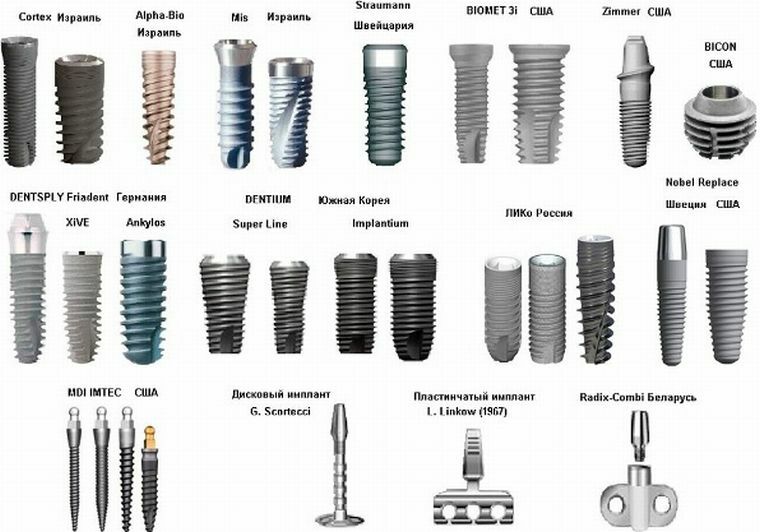
Abutment varieties
Modeling process
At the modeling stage, based on the results of tests and examination of the bone tissue condition, the doctor selects the optimal implants for the individual patient in shape, as well as their sizes.
In the selection process, the dentist takes into account the future inclination, the very location of the implant based on the artificial jaw. The next step is the direct installation of the implant - in this case it can be installed by the method of the puncture itself or by the incision.
So the first option will allow to carry out the entire procedure as painlessly as possible and without suturing - it is optimal for those who have a greater percentage of jaw loss due to its destruction. The second method is used by dentists after tooth extraction.
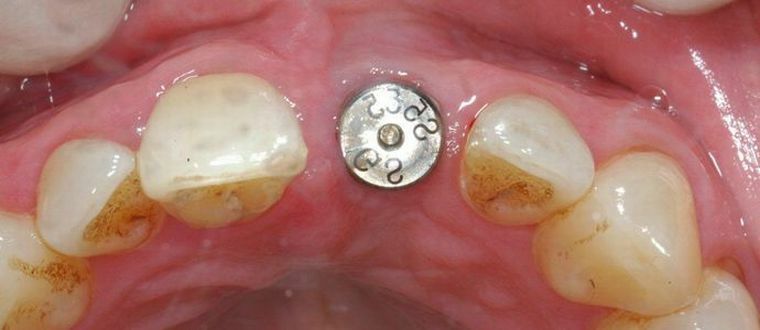
Basal implantation often uses a gingiva former - on the photo a silvery pin in the gum in the
. What the whole thing was for
. The final stage of the whole procedure is prosthetics - after the doctor installed the basal implant itself, the prosthesis can be put in 2-3 days and inIn this respect, there is a small primary load on it.
The entire prosthesis is made on the basis of casts - they are removed from the jaw of each patient individually. After that, it is on the basis of the resulting impression in the laboratory that implants are made.

Patient opinion
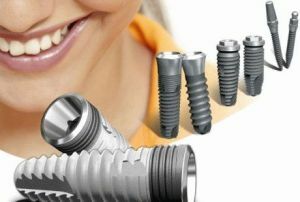 Basal implantation has found a large positive response among patients, which is confirmed by numerous reviews.
Basal implantation has found a large positive response among patients, which is confirmed by numerous reviews.
Many patients who have experienced a lot of problems with their teeth and used basal implantation during treatment and elimination of cosmetic defects speak with one voice of its painlessness and simplicity, which, you must agree, is important, as many adults and children are afraid of the drill.
In this case, such prosthetics are less traumatic than the classical version and the rehabilitation period is less prolonged. But in order not to be unfounded - just read the opinion of patients.
I have celebrated the birthday of my own teeth for 5 years already - yes, yes just like that. Everything happened on that summer day, when I chewed hazelnuts - as a result of a click and immediately 3 teeth crumbled. I had to remove these teeth, and as the neighboring 3 left much to be desired, I decided to install basal implants and I am very pleased.
The main thing is fast and not painful, and at the price the cost of the procedure itself is available to many, and what is most pleasant - I can now nibble nuts as I want and whenever I want, without fear for my own teeth.
Anna, 47 years old
About such procedure, as a basal implantation has heard from her doctor - dentist. I delayed with the treatment of teeth for a year and was very afraid of complications that can be after the installation of artificial teeth and prostheses.
Yes, and in regard to pain - I'm a big coward, but as it turned out, the whole process was almost painless and fast enough. Already after 2 weeks I could eat whatever I wanted, and all the implants stood still for more than a year and do not cause any problems, and in the care of them - everything is simple. And most importantly - the affordable price of basal implants and the entire operation.
Татьяна, 59 years
The word to the professional
Despite the fact that the technology of prosthetics itself has a lot of advantages and positive characteristics, but to achieve positive results and dynamics of treatment with basal implantation, it is worth remembering several important points.
All treatment conditions should ideally be selected, taking into account the clinical picture, suitable for the use of basal implants.
At the same time, it is worth taking into account both the skill and experience of the dentist himself and everything to do only with the use of quality material.
Otherwise, because of inexperience of the doctor, poor-quality material and sometimes banal haste - the result will be deplorable, when you just have to heal the patient after incompetent treatment of such a doctor.
Orthodontist dentist
Cost of treatment
If to speak about the cost of basal implantation, then the price of installation of the 1st basal implant, for example Swiss production, 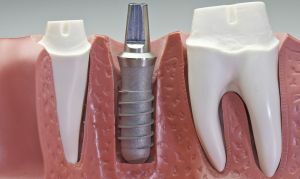 , together with the cost of the crown, is about 40,000 r.
, together with the cost of the crown, is about 40,000 r.
At the same time, the price of complete restoration of the dentition on one, upper or lower toothless jaw, basal implants of foreign production, is about 300 000 in the river. So in this amount included a survey, the installation of the necessary number of prostheses, anesthesia - all provided for by implantation technology.
Summing up, you can safely say that basal implantation is more optimal than the traditional classical procedure. It takes less time and effort, less traumatism, and when recalculating financial costs in comparison with the classical procedure - it is more profitable financially.
